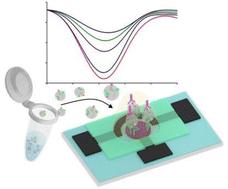Our official English website, www.x-mol.net, welcomes your feedback! (Note: you will need to create a separate account there.)
Low-cost electrochemical paper-based device for exosome detection
Analyst ( IF 4.2 ) Pub Date : 2022-07-01 , DOI: 10.1039/d2an00875k Surasak Kasetsirikul 1, 2 , Kim Thinh Tran 3 , Kimberley Clack 1, 3 , Narshone Soda 1 , Muhammad J A Shiddiky 1, 3 , Nam-Trung Nguyen 1
Analyst ( IF 4.2 ) Pub Date : 2022-07-01 , DOI: 10.1039/d2an00875k Surasak Kasetsirikul 1, 2 , Kim Thinh Tran 3 , Kimberley Clack 1, 3 , Narshone Soda 1 , Muhammad J A Shiddiky 1, 3 , Nam-Trung Nguyen 1
Affiliation

|
Exosomes are vesicles released by healthy and cancer cells into the extracellular matrix and bodily fluid. Cancer cell-derived exosomes have attracted much attention in early-stage detection and prognostication of treatment response. Thus, detecting exosomes is of great interest to biology and medicine. However, many conventional detection methods require high-cost equipment and centralized laboratory facilities, making diagnostics inaccessible in limited-resource settings. This study reports a proof-of-concept low-cost electrochemical paper-based analytical device to quantify both the total bulk and cancer cell-derived exosomes in cell culture media. The device employs a sandwich immune assay design, where exosomes are initially captured using the electrode-bound generic antibodies (i.e. CD9) and subsequently detected via ovarian cancer-specific CA125 antibodies. Our proposed device quantifies the total bulk exosome concentration with a detection limit of 9.3 × 107 exosomes per mL and ovarian cancer cell-derived exosomes with a detection limit of 7.1 × 108 exosomes per mL, with a relative standard deviation of <10% (n = 3). We suggest that this low-cost and simple electrochemical paper-based device could be an alternative tool for detecting disease-specific exosomes in biological samples with the potential to be further developed for point-of-care diagnosis.
中文翻译:

用于外泌体检测的低成本电化学纸基装置
外泌体是由健康细胞和癌细胞释放到细胞外基质和体液中的囊泡。癌细胞衍生的外泌体在治疗反应的早期检测和预测中引起了广泛关注。因此,检测外泌体对生物学和医学具有极大的兴趣。然而,许多传统的检测方法需要高成本的设备和集中的实验室设施,使得在资源有限的环境中无法进行诊断。本研究报告了一种基于概念验证的低成本电化学纸质分析装置,用于量化细胞培养基中的总体积和癌细胞衍生的外泌体。该设备采用夹心免疫分析设计,其中外泌体最初使用电极结合的通用抗体(即CD9),随后通过卵巢癌特异性 CA125 抗体检测。我们提出的装置量化总体积外泌体浓度,检测限为每毫升 9.3 × 10 7 个外泌体,检测限为每毫升 7.1 × 10 8个外泌体的卵巢癌细胞衍生外泌体,相对标准偏差 <10% ( n = 3)。我们建议这种低成本且简单的电化学纸基设备可以成为检测生物样本中疾病特异性外泌体的替代工具,并有可能进一步开发用于即时诊断。
更新日期:2022-07-01
中文翻译:

用于外泌体检测的低成本电化学纸基装置
外泌体是由健康细胞和癌细胞释放到细胞外基质和体液中的囊泡。癌细胞衍生的外泌体在治疗反应的早期检测和预测中引起了广泛关注。因此,检测外泌体对生物学和医学具有极大的兴趣。然而,许多传统的检测方法需要高成本的设备和集中的实验室设施,使得在资源有限的环境中无法进行诊断。本研究报告了一种基于概念验证的低成本电化学纸质分析装置,用于量化细胞培养基中的总体积和癌细胞衍生的外泌体。该设备采用夹心免疫分析设计,其中外泌体最初使用电极结合的通用抗体(即CD9),随后通过卵巢癌特异性 CA125 抗体检测。我们提出的装置量化总体积外泌体浓度,检测限为每毫升 9.3 × 10 7 个外泌体,检测限为每毫升 7.1 × 10 8个外泌体的卵巢癌细胞衍生外泌体,相对标准偏差 <10% ( n = 3)。我们建议这种低成本且简单的电化学纸基设备可以成为检测生物样本中疾病特异性外泌体的替代工具,并有可能进一步开发用于即时诊断。


























 京公网安备 11010802027423号
京公网安备 11010802027423号